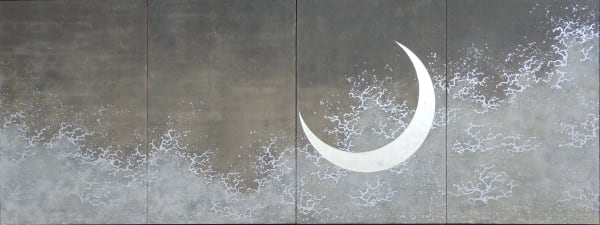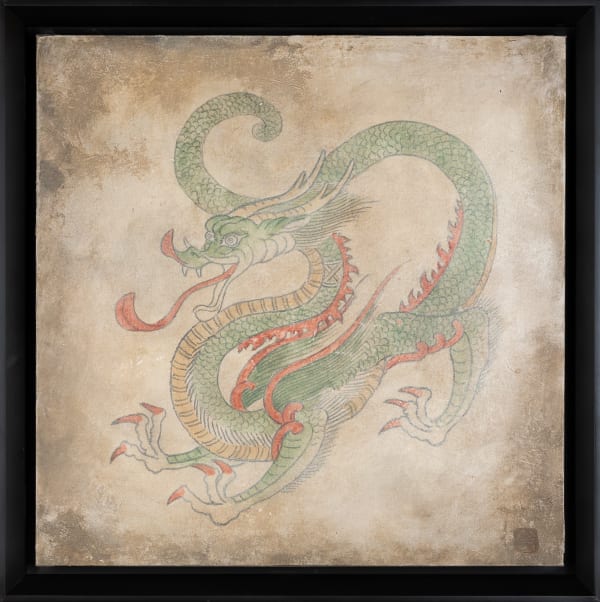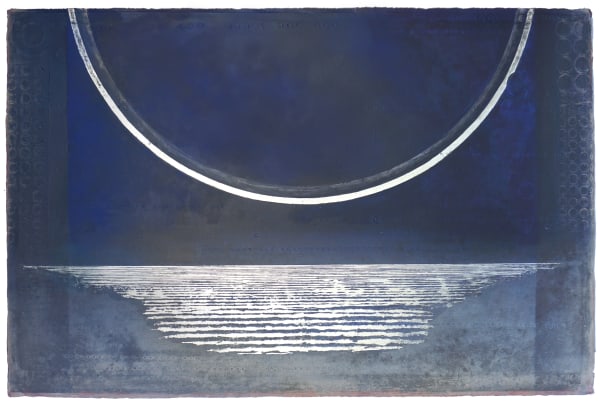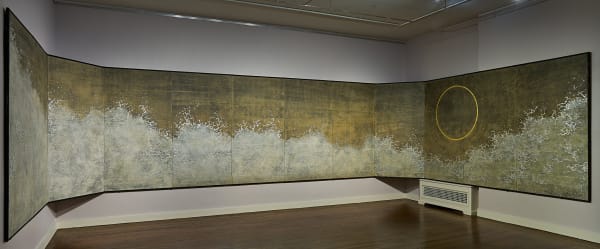Cosmic Sound: Master Paintings by Ken Matsubara
-
Overview
Infinite Echoes
A subtle call from the world of nature
Taken as summons from within
Fit together so movingly
That the unlimited sound takes shape.
— Ken Matsubara
Exhibition opens March 14, 2024 coinciding with Asia Week 2024.
- Opening Reception: March 14, 5 PM to 8 PM.
- All visitors are welcome: Thurs.—Sat. 11 AM to 6 PM.
- Gallery open by appointment only: Mon.—Wed. 11 AM to 6 PM.
-
Director's Letter
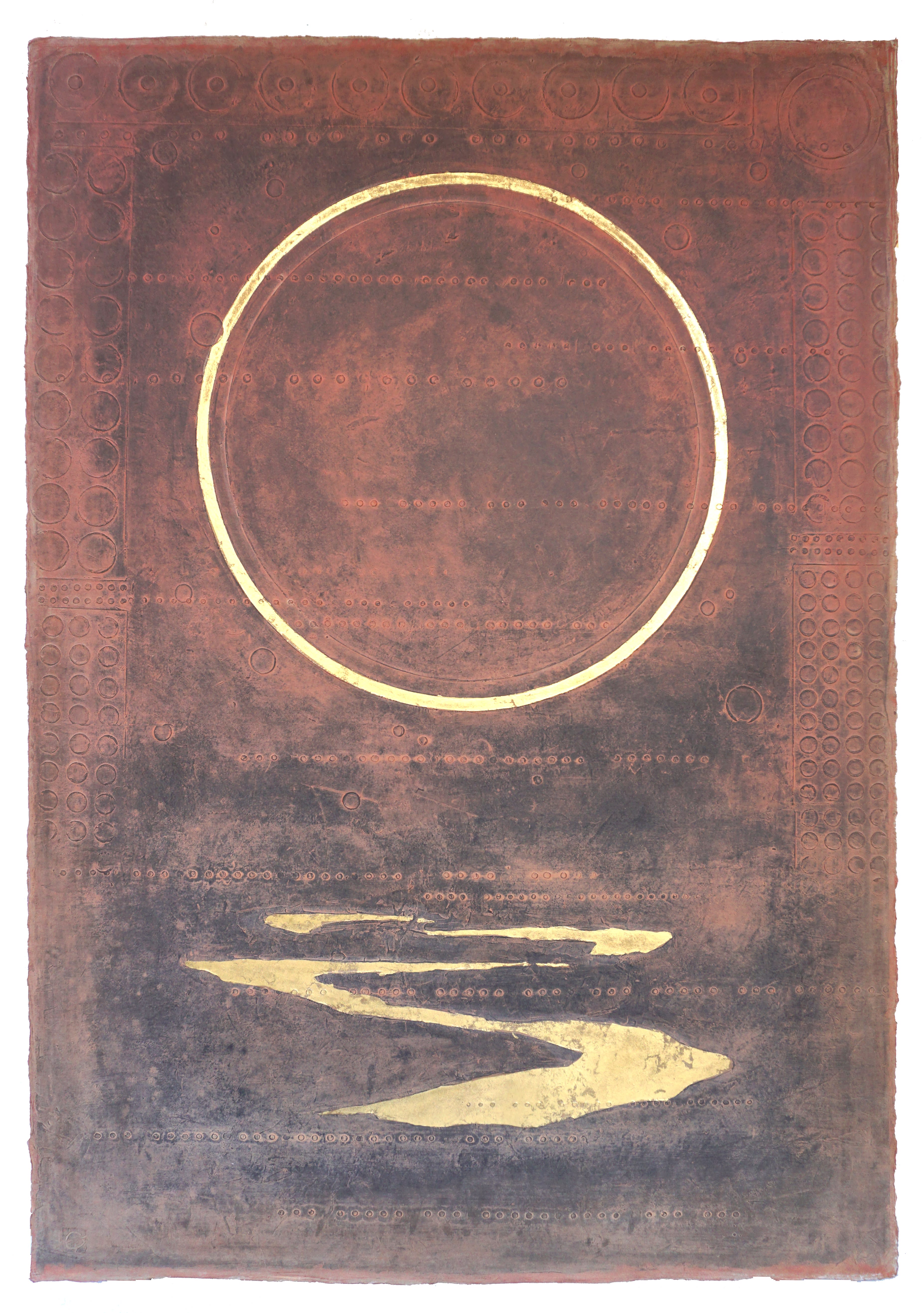
SUN, MOON, AND THE DAWNING OF TOMORROW
— Shoko Aono, February 2024
Sound echoes within Matsubara's paintings. The roar of the deep waves on the night sea; trembling air dancing about the incandescent stars. From the chaotic days of his youth (Chaos (1983), collection of the Minneapolis Institute of Arts, Minneapolis, MN), through to his subsequent phases; that of ‘purification’ made with abundant use of water (“Kei” Scenery series) and those spectacular screens—depicting the challenging landscape as seen by the charismatic Buddhist monk Kukai of the Heian period—in which sky and sea are brilliantly illuminated by the sun and moon (“Gengetsu” Kukai's View; Sun and Moon, Waning Moon (2017), collection of the Philadelphia Museum of Art, Philadelphia PA). He will present his fourth solo exhibition at Ippodo Gallery NY this spring: his point of origin so to speak, Matsubara’s new works includes his sound-based series and "Kyokujitsu Gyosei" Kukai's View; Sun and Venus, often said to be the moment when Kukai reached enlightenment; "Venus jumped into his mouth.” The heart of Matsubara’s latest works is warm and nostalgic like his recent “Shoku” Sunset series.
At 31 years old, following the loss of his teacher and guiding light Sanko Inoue, Matsubara—spirit depleted—lay in the main hall of a temple surrounded by mountains in Imajo, Fukui Prefecture, where his elder brother had lived. A warm and pleasant voice, like chanting the Buddha’s name, filled the main hall. One step outside the main hall, and he could no longer hear the soothing sound. Later, Matsubara learned that voices from the town's election campaign speeches had echoed off the intertwining mountains, creating a strange soundscape within the walls of the main temple hall. It was a moment of discovery which reverberated through Matsubara’s body and soul, saying to himself, “This is the nature of abstraction.” All the noise of the ordinary world is purified, transformed, and sublimated by nature. That is the truth of music and abstraction.
This realization sank into his thirsting heart, quenching his troubles and sprouting a creative fountain from which his artistic life began. Thus the "Sound" series was born. Matsubara began to mix his own paints with primitive materials such as clay (tonoko powder), iron oxide (bengara powder), and black ink (soot). No matter the season, his paintings are done outdoors in both days of cold and heat. He sought the source from which humans painted since ancient times, in caves and the like where no light permeates. Matsubara’s free and flexible mode of expression was born. Sound has since appeared in the form of a circle throughout his works. Like the excited molecules of energy that compose a gaseous state, viewers' hearts cannot help but vibrate and thump along in excitement.
For this exhibition, Matsubara chose 明 “mei” as the underlying theme. The Chinese character is composed of two radicals: "day" and "moon," representing brightness, clearness, and intelligence. Just as tomorrow will surely dawn, even after a pitch-dark night, there is hope that in the darkness of today's world, people will mature, become wise, and illuminate the way ahead for those that come next.
-
Works
-
-
Installation Shots
-
Press Release
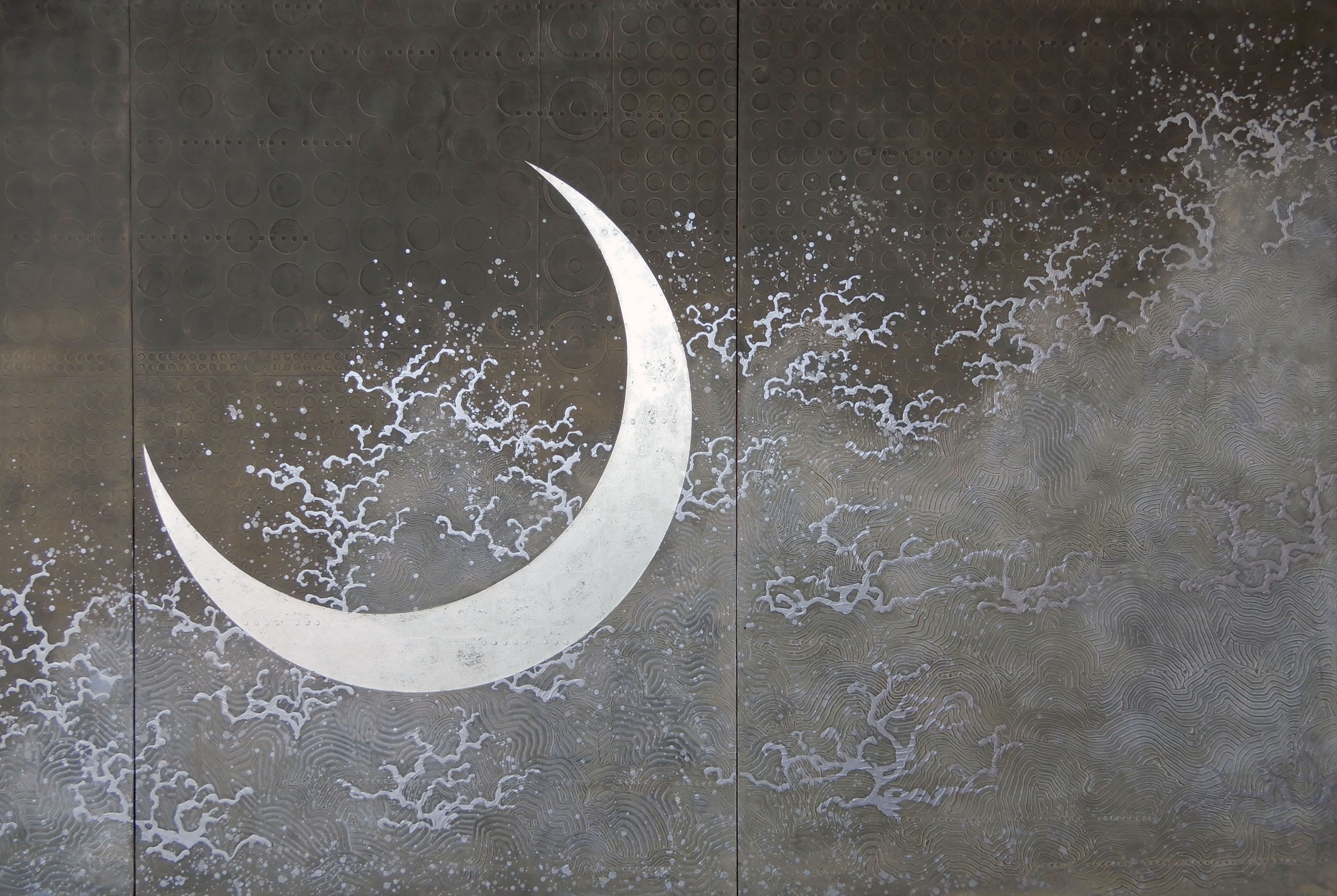
New York, NY – Ippodo Gallery proudly announces Cosmic Sound: Master Paintings by Ken Matsubara, a culmination of the artist’s concepts featuring 20 of the beloved painter’s unique artworks from March 14 to April 4, 2024, coinciding with Asia Week 2024. Matsubara showcases series spanning his long and illustrious career, including three works depicting the auspicious and fearsome dragon zodiac, the spectacular 12-panel Kūkai’s View, and versions of Scenery and the Moon Sound. Please join Ippodo Gallery for an opening reception with the artist on March 14, 2024.
Ken Matsubara (b. 1948) came to the medium of painting as a young man living amongst monks at a Buddhist temple in north-central Japan. Now residing in Nasu, Tochigi Prefecture, a natural landscape of rivers and waterfalls, Matsubara sojourned across the Japanese archipelago, finding inspiration through researching local imaginations of the dragon—sometimes a sky god or spirit of the water. The transcendental themes of his youth continue to permeate his works. One universal symbol is the circle, symbolizing the resonant sound of a ringing prayer bowl. The repetitive shape muddies the separation between sun or moon, sky or sea, or foreground from background: all is one and one is all.
Pigments derived straight from the earth comprise Matsubara’s iconic technique. Many of his works are primed with an oxidized iron dye called bengara on Echize washi paper, a localized method of papermaking native to the region of Matsubara’s hometown in Toyama prefecture. Local stories fuel Matsubara’s inspiration, including his Sun & Moon series that reimagines the tale of a cave-dwelling aesthetic monk gazing up at the celestial bodies.
Matsubara’s paintings and works on traditional Japanese mediums such as folding screens (byoubu) are in esteemed collections including the Minneapolis Institute of Art, where Matsubara’s Chaos (1983) is on view alongside the antique Taima Mandala through mid-April 2024.
Matsubara’s unique evolution on traditional Japanese painting, the monk Kūkai’s cave view of the moon, is also in the possession of the Philadelphia Museum of Art and was highlighted in the museum’s most recent publication, “Art of Japan” (2023).
The artist has held group shows at the Tokyo Metropolitan Museum, Ueno Royal Museum, the Barcelona Museum of Contemporary Art, and many more esteemed institutions. In acknowledgement of his talents, Matsubara has received many awards, including the Dai-ichi Bijyutsu Award, the Kanazawa Prefectural Assembly Chairman’s Award, the Special Award at the INF International Art Exhibition, among others.
-
Artist Talk
Moderated by Ippodo Gallery NY Director Shoko Aono; COSMIC SOUND: Master Paintings by Ken Matsubara opens on March 14, 2024 with Asia Week NY. February 21, 2024In this next installment of our Artist Talk series, Ippodo Gallery NY director Shoko Aono facilitates a conversation between the legendary Felice Fischer, Curator Emerita of Japanese Art at the... -
Publications
-
Matsubara's Inscription
Sun and Moon: Kūkai's ViewInscribed beneath the paint on each of his iconic fusama and byobu, Matsubara imbues his Kūkai's View series with words that tell of the mind of the secluded monk Kūkai:
...
The Precious Key to the Secret Treasury
From the dim, remote, and immemorial past,
Texts are transmitted in a thousand and ten thousand tomes,
Elucidating Buddhist and non-Buddhist teachings.
Abstruse, obscure, and indistinct
Are a hundred opinions and theories...
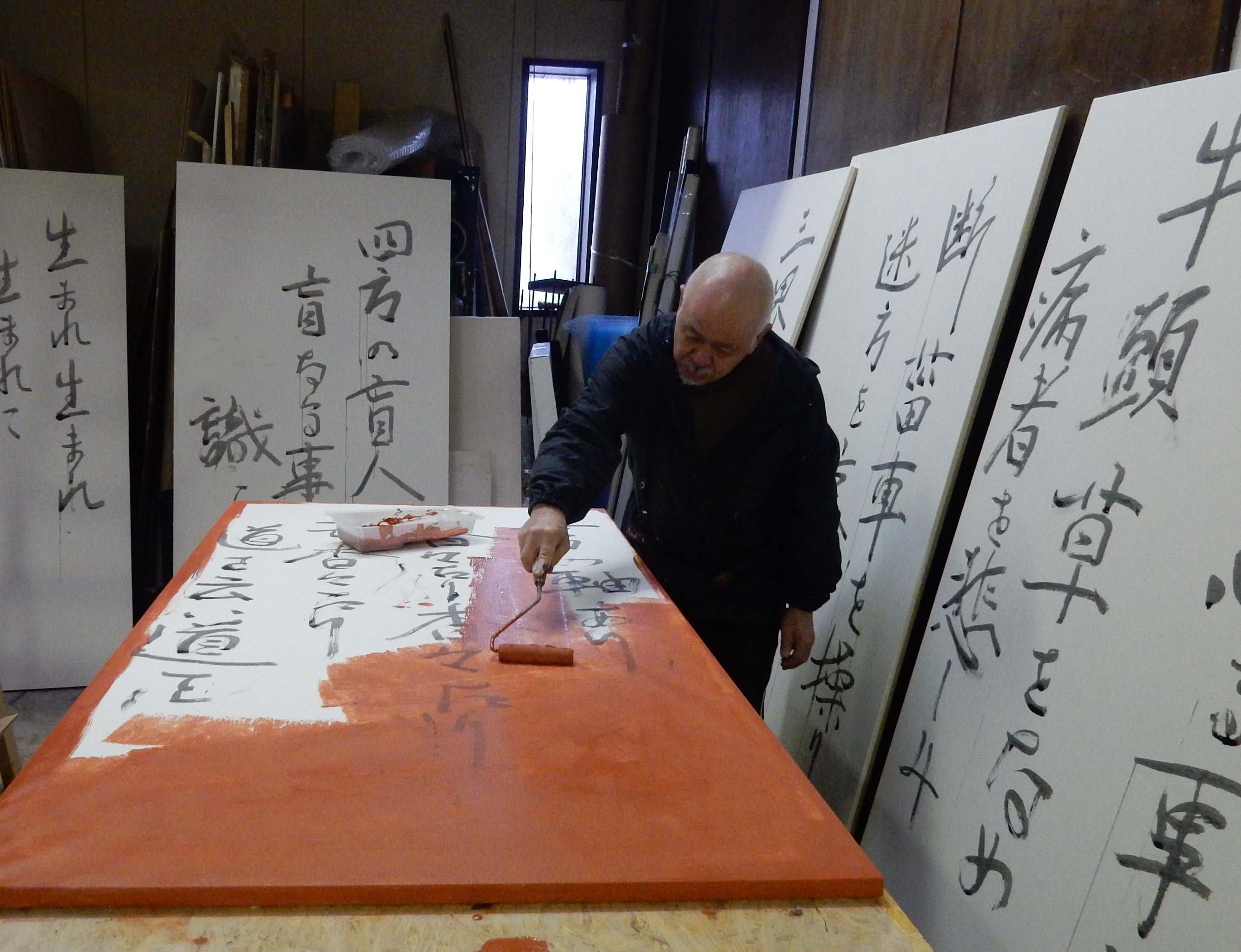
...
Each claiming to be the final way.
Copying and reciting until one’s death,
How can one penetrate the ultimate Source?...
I do not know, however I ponder.
The Buddha, I believe, had no mind for this.
He took pity on diseased minds
And taught them to take medicinal herbs as Shen Nung did.
Out of compassion, he showed the direction to the lost,
As did the Duke of Chou by making the compass-cart.
...
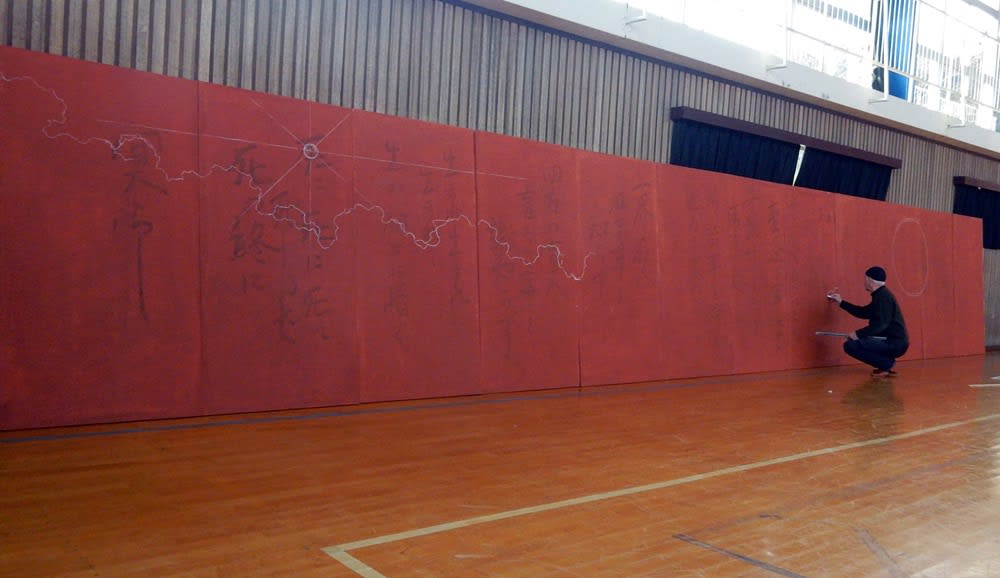
...
But deranged men do not perceive their madness;
The blind are unaware of their blindness.
Born, reborn, and still born again,
Whence they have come they do not know,
Dying, dying, and dying yet again,
Where they go in the end they do not know.
...
[Translation by Yoshito S. Hakeda, Kūkai (New York: Columbia University Press, 1972), 157–224.]
-
Events


